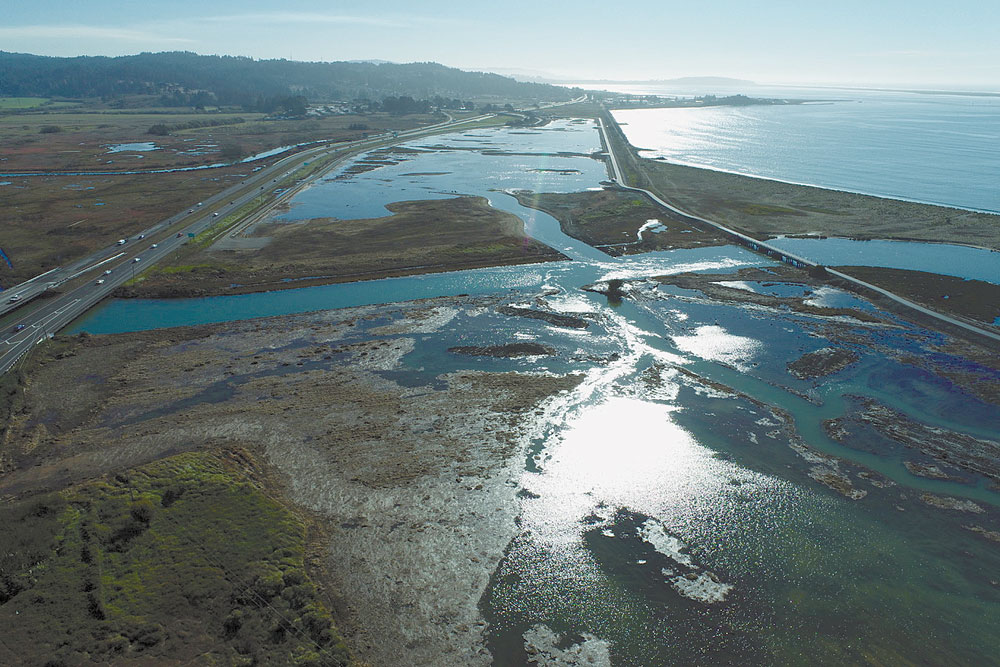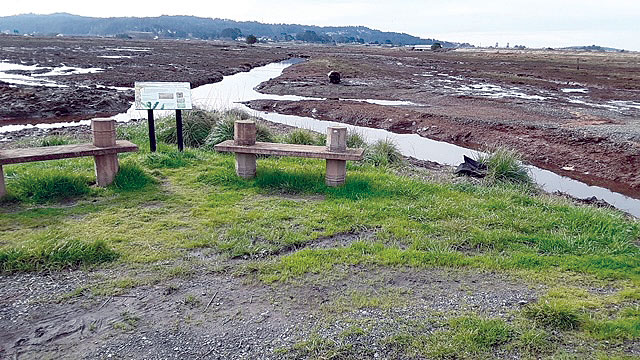Elk River Estuary Enhancement Project: Making Things Right

Friends of Elk River
By Jerry Martien
The difference between water and land has been especially muddy this winter, but for the Elk River Estuary Enhancement Project, that was part of the plan. Two City of Eureka parcels near the mouth of the river, more than 120 acres of “reclaimed” pasture and degraded salt marsh, will once again become a functioning intertidal ecosystem.
Throughout fall, travelers on 101 between Herrick Road and Humboldt Hill were entertained by a moto-cross of loaders and dump trucks taking out old dikes and dams, re-digging buried tide channels on the south side of the river. On the north side, along Pound Road and Hikshari’ Trail, crews with hand tools and weed whackers cut back invasive Spartina grass while Swampmasters crawled through newly uncovered channels.
At high tide, it looks like part of the bay. At low tide it looks like a big muddy mess—but we all know recovery can be ugly in its early stages.

A New Trail Replaces Old Infrastructure
Originally proposed by Aldaron Laird and funded by the State Coastal Conservancy, the project began as a way to accommodate sea level rise. But it also removes old tide gates and barriers to fish migration, opens up nearly three miles of water for non-motorized boating, and re-purposes thousands of cubic yards of sediment, the product of upstream logging, into a pedestrian and bike path that extends from Elk River to a new access point at Humboldt Hill.
The new trail is already popular. Elevated well above high tide, paved, two lanes wide, it even features a center line and traffic signs. A lot of trash was cleaned up. There are pull-outs for wildlife viewing. Walking and biking is almost like motoring.
Not everyone is pleased by these changes. Fishermen, beach strollers, and dog walkers used the old trail for many years. They complained about lack of public access during construction and called attention to the destruction of existing wildlife habitat. A big muddy mess.
Restoration also uncovers old mistakes. This place is still known to many locals as Stinky Beach. The pasture was once a place where they spread the solids of Eureka’s sewer plant. Across the river, Pound Road leads to the old concrete ruins where the City caged and disposed of its excess dogs and cats. They went next door to the rendering plant, along with dead livestock and leftovers of the slaughterhouse, to be cooked into a malodorous commercial product that mingled with the fog and sulfurous exhaust of two pulp mills.
Restoration has to ask what we hope to bring back to this place. Its older Wiyot name is Hikshari’, a site of continuous settlement and “management activity” for many centuries. When Laird & Associates drew up plans for reconstructing the estuary, they ensured it was done in consultation with Wiyot representatives. Laird prefers to call what they’re doing enhancement: “We are not returning the area to what it was before white people came here.” After recovery, it’s important to accept the things that can’t be changed.
The Many Facets of Restoration
Restoration means education and change, as much as engineering and botany. The City of Eureka has demonstrated, when it returned Tuluwat Island (formally Indian Island) to the Wiyot, that it can also mean acceptance, reparation, and land return. Making things right. Calling places by their Wiyot names. Hikshari’.
Restoration also applies to governance, changing the ways we make public decisions, being more inclusive and open. People in Elk River only learned of this project because it got attached to another murky issue we have followed for years. At a meeting of the North Coast Regional Water Quality Control Board, in 2016, while Elk River residents waited to ask the board to take effective action to reduce sediment (they didn’t), Eureka officials were told that their sewer plant was in violation of state and federal water quality laws. Its effluent was illegally going into Humboldt Bay (and Elk River’s estuary). But the timber companies got their zero-sediment logging plan, and the City was given five years to fix their waste system.
Seven years later, Eureka and regional water quality staff were claiming the Elk River Estuary Enhancement Project would “mitigate” their problem—basically, make it go away. That claim hasn’t come up again since an environmental law firm sued the City for its criminal behavior—and won—but meanwhile, time and effluent move on.
Then another piece of the story came to the surface at a Humboldt Community Services District (HCSD) meeting. The old pound property, owned by Figas Construction, the low bidder on the project, would be the site of a $4.2 million Nature Center. Because HCSD is Eureka’s junior partner in the wastewater plant, serving rate payers from Freshwater to Fields Landing (not Elk River), they would want to help pay for this additional “mitigation” of the plant’s pollution. HCSD strongly objected, and the Nature Center sank out of sight with the mitigation claims. Its status remains unclear.
The Mallards Like It
Recovery from old habits requires time and constant vigilance. This project is a good beginning. Many people should be thanked for their contributions, but especially project manager Katie Marsolan, the drivers and equipment operators for their long hours, the tireless weed whackers and hand diggers of Redwood Community Action Agency, and Samara Restoration for its care in returning native plants to this damaged landscape.
A few mallards have been seen checking things out. A hopeful egret. A small flock of sanderlings that came over from the beach. Nature will heal before we do.
For more information: treesfoundation.org/partner-groups/friends-of-elk-river/
